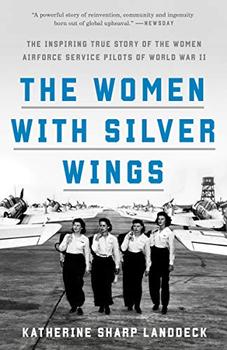Page 4 of 4
There are currently 25 member reviews
for The Women with Silver Wings
-
Judith G. (Ewa Beach, HI)
Trivial Pursuit info
Great personal stories of five of the original pilot groups. I met a WASP on a tour to Cuba in 2000. Wish she'd been mentioned. The best part of this non-fiction for me was the final chapters (starting on page 263) telling of the women's lives after the flying group was disbanded.
-
Barbara B. (Evansville, IN)
Courageous Women as Service Pilots
Apparently, it was a popular thing for middle-class and upper-class women to earn their pilots' licenses in the late 1930's. However, the male pilots were reluctant to share the skies and duties with their female counterparts. Midway through World War II, it became necessary for women to step up and help, especially with ferrying airplanes from the factory to the military bases. The female pilots were civilian members and did not receive military benefits until many years later, during President Jimmy Carter's administration. This nonfictional account featuring the history of the WASPS, is quite detailed and well researched. The book features the personal lives and aviation of five important members of the service pilots.
-
Peggy A. (Fairfax, VA)
The Women With Silver Wings
As the United States entered World War II, there were lots of women inspired to do whatever they could do to help our nation in this time of war.
A group of women pilots were invited to join the U. S. Army Air Forces as civilians. More than a thousand young women pilots volunteered to help ferry airplanes from factories to their needed locations.
This is the story of these courageous women, not eligible for combat, who did the work of men so that they could go into combat, and their lives after the war; even to their deaths.
This information is new to me and I found it very interesting. I would definitely recommend it to others.
-
Joy E. (Rockville, MD)
What Did You Do in the War, Granny?
The Women with Silver Wings is a nice addition to the growing library of books about unsung women doing nontraditional jobs very successfully, especially during World War II. Women pilots were not allowed in the U.S. military until the 1970's, but more than one thousand women flew military planes during the second world war, mostly ferrying the planes from factories to places where there were needed. (They were considered civil servants rather than military.) This book tells the history of these piloting assignments and of some of the talented, brave, and determined women who undertook this mission. During the war they never received the military standing they deserved and it was not until more than thirty years later that Congress finally passed legislation giving these women some of what they were due. Although perhaps too much detail is provided on the post-war fight for military recognition, the first two-thirds of the book is a spirited description of lively young women doing a job they loved regardless of the obstacles in their path.
